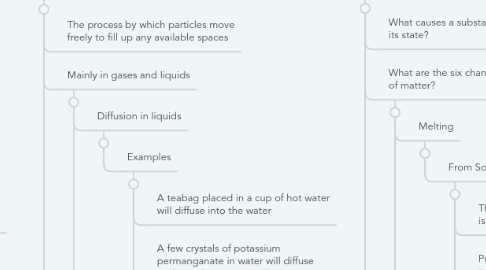
1. 𝐌𝐚𝐭𝐭𝐞𝐫
1.1. A substance that has mass and occupies space. It is made up of tiny particles that are in constant random motion.
1.1.1. Solid
1.1.1.1. —Orderly
1.1.1.2. —Closely Packed
1.1.1.3. —Vibrating about in fixed position
1.1.1.4. —Cannot be compressed
1.1.1.5. —Fixed Volume
1.1.1.6. —Very Strong Forces
1.1.2. —Fixed Shape
1.1.3. Gas
1.1.3.1. —Disorderly
1.1.3.2. —Very far apart
1.1.3.3. —Move freely in a container
1.1.3.4. —Can be compressed
1.1.3.5. —Takes shape of container
1.1.3.6. —Shape is not fixed
1.1.3.7. —Volume is not fixed
1.1.3.8. —No forces
1.1.3.9. —Forces are negligible
1.1.4. Liquid
1.1.4.1. —Disorderly
1.1.4.2. —Less closely packed than solid
1.1.4.3. —Able to move freely within volume of liquid
1.1.4.4. —Cannot be compressed
1.1.4.5. —Takes shape of container
1.1.4.6. —Shape is not fixed
1.1.4.7. —Fixed Volume
1.1.4.8. —Strong Forces
2. 𝐃𝐢𝐟𝐟𝐮𝐬𝐢𝐨𝐧
2.1. The process by which particles move freely to fill up any available spaces
2.2. Mainly in gases and liquids
2.2.1. Diffusion in liquids
2.2.1.1. Examples
2.2.1.1.1. A teabag placed in a cup of hot water will diffuse into the water
2.2.1.1.2. A few crystals of potassium permanganate in water will diffuse and turn the water purple
2.2.2. Diffusion in gases
2.2.2.1. Examples
2.2.2.1.1. Cigarette smokes diffuse into the air
2.2.2.1.2. You can smell perfume because it diffuses into the air and makes its way into your nose
2.3. What are the two factors that can affect the rate of diffusion?
2.3.1. Temperature
2.3.1.1. When matter is heated, the particles of matter absorb energy which causes them to move faster
2.3.1.2. Therefore, the higher the temperature, the faster the particles move, and so the faster the rate of diffusion
2.3.2. Molecular Mass of Gases
2.3.2.1. The lower the molecular mass, the faster the rate of diffusion
3. 𝐂𝐡𝐚𝐧𝐠𝐞𝐬 𝐢𝐧 𝐬𝐭𝐚𝐭𝐞𝐬 𝐨𝐟 𝐦𝐚𝐭𝐭𝐞𝐫
3.1. What causes a substances to change its state?
3.2. What are the six changes in the states of matter?
3.2.1. Melting
3.2.1.1. From Solid to Liquid
3.2.1.1.1. The temperature at which it changes is called its melting point
3.2.1.1.2. Pure substances has a fixed melting point
3.2.1.1.3. Different substances have different melting point
3.2.2. Freezing
3.2.2.1. From Liquid to Solid
3.2.2.1.1. The temperature at which it changes is called its freezing point
3.2.2.1.2. A pure substance melts and freezes at the same temperature
3.2.3. Evaporation
3.2.3.1. From Liquid to Gas
3.2.3.1.1. It occurs at temperature lower than its boiling point
3.2.3.1.2. Why do liquids evaporate?
3.2.3.1.3. In what way is evaporation different from boiling?
3.2.4. Condensation
3.2.4.1. From Gas to Liquid
3.2.5. Boiling
3.2.5.1. From Liquid to Gas
3.2.5.1.1. The temperature at which it changes is called its boiling point
3.2.5.1.2. Different substances have different boiling points
3.2.6. Sublimation
3.2.6.1. From Solid to Gas
3.3. When matter is heated or cooled, the heat taken in or given out causes kinetic energy of particles to change. As a result, substances change its state.
3.4. What happens to the particles of these substances during its changes in states of matter?
3.4.1. Melting
3.4.1.1. 1. Heat energy is absorbed by the particles in the solid. The heat energy is then converted to kinetic energy. The particles start to vibrate faster about their fixed position
3.4.1.2. 2. When the temperature is high enough, the vibration of the particles become sufficient to overcome the attractive forces between them
3.4.1.3. 3. The particles begin to break away from their fixed positions. The particles are no longer in their fixed positions. The particles slide over one another. The substance is now a liquid.
3.4.2. Freezing
3.4.2.1. 1. Energy is given out by the particles of the liquid. The particles lose kinetic energy and begin to move slowly
3.4.2.2. 2. When the temperature is low enough, the particles no longer have enough energy to move about freely. Some particles start to settle into fixed positions
3.4.2.3. 3. All the particles settle into fixed positions. Particles can only vibrate about their fixed positions. The substance is now a solid.
3.4.3. Heat energy is absorbed by the particles of the liquid. The heat energy is converted to kinetic energy. The particles start to move faster as the temperature rises. When the temperature is high enough, the particles have enough energy to overcome the forces of attraction holding them together. The particles can now spread far apart and move rapidly in all directions. The substance is now a gas.
3.4.4. Boiling
3.4.5. Condensation
3.4.5.1. When a gas is cooled, the particles lose energy in the form of heat energy. During condensation, heat energy is given out by the gas particles. As the temperature drops, the gas particles lose energy and move more slowly. Eventually, the movement of the particles become slow enough for the gas to change to liquid.
